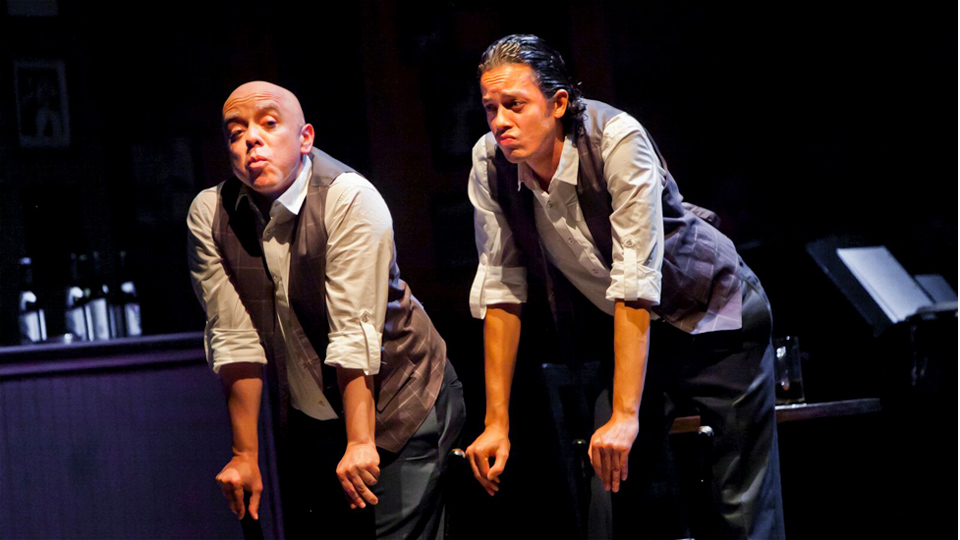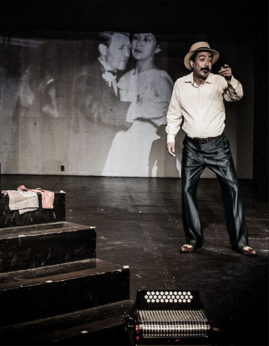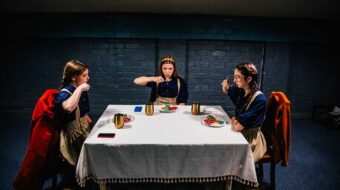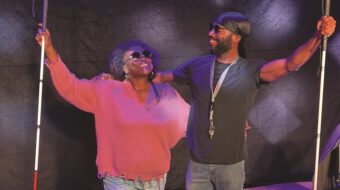
LOS ANGELES — Encuentro de las Américas! We’ve just started an 18-day “encounter” of 14 theater companies from around the U.S. and from Canada, Peru, Colombia, Cuba, and Mexico, all at downtown’s Los Angeles Theatre Center (LATC) through November 19th. The plays are presented in repertory, with performances running simultaneously Thursday through Sunday in the five spaces that comprise the LATC complex. I’ve already seen four productions opening weekend (actually five) and plan to see four more. They are staged in Spanish, English or both, with supertitles.
The fifth one I already saw was a preview to Encuentro—La Razón Blindada (Armored Reason)—based on Don Quixote fantasies spun out by two Argentine political prisoners that played a few weeks ago at the 24th Street Theatre here in L.A.
Let’s talk today about two of the plays, both with important musical content, that speak movingly and lovingly of the immigrant experience in the United States.
El Apagón (The Blackout) retells a story about the Great Northeastern Blackout, which significantly disrupted the supply of electricity on Tuesday, November 9, 1965, affecting parts of Ontario, Canada, and the U.S. states of Connecticut, Massachusetts, New Hampshire, New Jersey, New York, Rhode Island, Pennsylvania, and Vermont.
A production of the Pregones Theater in The Bronx, N.Y., El Apagón was adapted for the stage by Alvan Colón-Lespier, Jorge B. Merced and Rosalba Rolón, and directed by Rolón. It features two principal actors, Jorge B. Merced and Flaco Navaja, and a lovely band of four musicians: Hammadi Bayard on sax and flute, Waldo Chávez on bass, Desmar Guevara on piano, and Nicky Laboy on percussion. Acclaimed as “the quintessential ‘Boricua’ play” (Boricua is a slang word for Puerto Rican), the production is an adaptation of the short story “The Night We Became People Again” (“La noche en la que volvimos a ser gente”) by José Luis González, performed in intermingling Spanish and English, and set to the beat of popular Latin songs from the 1950s and ’60s. The premise is that while riding the New York subway uptown from Brooklyn to El Barrio, the Latino enclave on Manhattan’s Upper East Side, eager to witness the birth of his firstborn, a nameless Puerto Rican factory worker and his best friend Trompoloco are caught in the blackout.
The set is a modest bar. The story is told years after the fact about a seminal date in New York, Latino, and these individuals’ personal histories. One of the ways the production keeps the eye and mind excited is that the two actors, who look like a kind of Mutt and Jeff team, interchangeably switch roles in the storytelling. Trompoloco is a lovable simpleton people enjoy having around and watching out for (the name translates as a crazy man or spinning top). But both actors have developed their particular takes on the character, as they also do on the factory worker who asks his foreman in Brooklyn if he can clock out early today to participate in his wife’s childbirth.
Many in the audience (Nov. 4) knew the songs of the era and sang along at the invitation of the actors. Flavio Navaja is, aside from his prodigiously rubber-man acting skills, an enchanting singer. There was actually one moment of audience participation that made me cringe ever so slightly, when the worker says the sympathetic foreman was Jewish. “And you know,” the worker prompted the house, “what comes first” for Jewish people—and the audience responded, “Family!” Pleased though I was to hear my peeps get a little spontaneous prop, I also shrank from it, wondering, Would a foreman of any other background be so much less sympathetic to letting a worker off early for such an important event? Maybe the author felt a special debt of gratitude he needed to acknowledge. Well, I count it as a small gesture of grace in a larger tale full of adventures.
Women, the characters tell us, are better at factory work than men: They spend their time gossiping and they don’t tend to get drunk. A sort of backhanded compliment, but after all, the sexes are always contested ground in one arena or another. They didn’t note whether in 1965 the women’s wages were equal to the men’s; I wonder what the Jewish foreman might have had to say about that.
All the characters’ asides and recollections about the people at work, on the streets, in the subway, reflect the multicultural nature of life in the big city, the interactions that define the spirit of New York. Somewhere north of 42nd Street the lights go dark between stations and the train grinds to a halt. The rush-hour crowd walks single file along the track. It’s probably a good thing the play runs only just over an hour because there’s a passage where Trompoloco has to take an urgent piss that, if the play were any longer or the scene more extended, might have had theatre patrons rising from their seats from the power of suggestion and heading out the back door.
Finally out on the street again, the pair sprint north in the darkness to the worker’s apartment. The only light in all of New York City comes from passing cars and, once indoors, from candles. The birth has already taken place, attended by the midwife and a clutch of neighbors. It’s a boy!—this first-time father’s prayer. What will we name him? he asks. “Same as the father,” the new nameless mother answers, “so he doesn’t forget he has a son.” Hints of some dissonance in this relationship?
The new baby is almost a miracle child. As the couple looks into his face, determining if he resembles the father or not, the funniest single moment in the show takes place: The entire band gets up from their chairs to stare in wonderment at the infant. I couldn’t help thinking this is almost a Christmas story with a visit from the Magi, but isn’t that truly the sense of sacred specialness every new parent feels? That Great Northeastern Blackout baby is now an AARP member!
But another miracle happened that night as well: All over the city, including on this building’s rooftop, neighbors gathered to party. Latino musicians joined in and celebrated the celestial event: For the first time since they left their Puerto Rican homeland, these migrants to jobs and schools and apartments in New York could appreciate the skies overhead. “We forgot the stars existed.”
“I thought of everything we left behind in Puerto Rico,” the factory worker says, “because of need…. That was the night we became people again.”
El Apagón was booked in Encuentro months ago, but unexpectedly now there is another apagón in Puerto Rico itself in the aftermath of Hurricane Maria. There are small gestures by individuals, unions, church groups and other charities to help out, but the federal government is woefully failing our fellow U.S. citizens there. I doubt that wistful, charming plays will ever be written about this sorry episode masterminded by our own maladroit in chief, Trumpoloco.
Singing the conjunto blues

From San Antonio, Texas, the Guadalupe Cultural Arts Center sent Conjunto Blues to Encuentro. This virtually one-man show by Nicolás Valdez weaves a personal narrative that, he told me after the performance (Nov. 5), is “95% autobiographical.” It’s beautiful social history, capturing the spirit of the Mexican-American working class across several decades of the 20th century, mostly in Texas but spreading out across the Southwest and up into places like California, Michigan and Illinois, where Mexican-American migrants have found livelihood and homes.
Valdez is a master of the diatonic button accordion, first introduced to Mexico and the Southwest by German immigrants but soon picked up by Latino musicians. That’s why the polka is still one of the genres performed by conjunto bands that feature the accordion with an added bajo sexto, or bass accompaniment. Other musical styles have also been incorporated into the conjunto sound, including jazz, rock ’n roll, blues, boleros and more. Conjunto, says Valdez, is basically “European music with a jalapeño flavor.” Valdez himself is a graduate of the Guadalupe Cultural Arts Center program, where he studied under the revered master Valerio Longoria.
He starts off speaking with a surprising Irish brogue, trying to link some of his personal family history to the Irish immigrants to America who were drafted into the Mexican-American War of 1846. After a bit, they found they had more in common with Mexico than with the U.S. and switched sides. Their progeny have contributed their DNA, and their music, to Mexican culture. Overnight, proud Mexican citizens had the border yanked out from under them: In the United States they became an underdog nation.
The play is a perfectly balanced mix of family stories and history of the larger phenomena of people, borders and labor, film documentary clips, projections, and of course Valdez’ stupendous playing and singing, accompanied by Luis Gonzalez on guitar. He pays tribute to the men and women who made him who he has become, with special acknowledgment of his grandfather Don Ramón Valdez and his teacher Longoria.
Conjunto was the soundtrack to the Mexican-American experience. Troupes of musicians traveled out to the fields to entertain the farm workers, a tradition that holds to this day. And in time, ambitious entrepreneurs opened cantinas, bars and clubs where performers played on stages sometimes little more than a dusty dirt clearing. Recording companies captured the conjunto sound on disk. The musicians were happy to get their music out, and maybe aired on local radio stations, but they were compensated poorly—$15 a song and no copyright protection.
Almost none of these musicians survived on their music alone. Most had other jobs. During the Depression they wandered everywhere to pick fruit and vegetables, and when war came they served in the armed forces. Valdez recounted how his grandpa delighted the Germans when the war ended—this brown-skinned Mexicano from Texas almost inexplicably playing all their familiar polkas and waltzes on his little squeeze box. Many Mexican-Americans migrated permanently to Chicago, Detroit, Saginaw, wherever good-paying jobs awaited them, dressed up in their finest on the weekend to play or to enjoy the conjunto music that made them feel so right.
The play title includes the word “blues,” and Valdez does not shirk from recounting some of the hardships of Mexican-American life—the racism and exploitation, the uprooting of communities, and for some the excesses of alcohol, drugs and philandering, especially for lonely musicians on the road.
What a gift to this country is Nicolás Valdez!—not only as musician but as an expressive singing actor, social historian and winsome raconteur. If the accordion gave voice to generations of strugglers for a better life, it inspires us still, with its nearly symphonic potential to summon up every human emotion. “Playing the music itself,” he says, “is an act of revolution.” As we progress, he asks, “What do we take with us as we move forward?”
Performances continue at The Los Angeles Theatre Center, 514 S. Spring St., Los Angeles 90013 through Nov. 19. Go to www.thelatc.org to find a schedule.












Comments